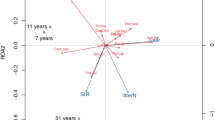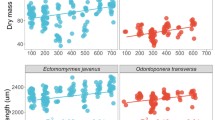Abstract
Tree carbon allocation is a dynamic process that depends on the tree’s environment, but we know relatively little about how biotic interactions influence these dynamics. In central Kenya, the loss of vertebrate herbivores and the savanna’s invasion by the ant Pheidole megacephala are disrupting mutualisms between the foundational tree Acacia (Vachellia) drepanolobium and its native ant defenders. Here, we piloted a 13Carbon (C) pulse-labeling method to investigate the influence of these biotic interactions on C allocation to ant partners by adult trees in situ. Trees withstood experimental conditions and took up sufficient labeled 13CO2 for 13C to be detected in various C sinks, including ant mutualists. The δ13C in ants collected shortly after labeling suggested that trees exposed to herbivores allocated relatively more newly assimilated C to native ant defenders. Our results demonstrate the viability of the pulse-labeling method and suggest that C allocation to ant partners depends on the biotic context of the tree, but further investigation with replication is needed to characterize such differences in relation to invasion and herbivore loss.





Similar content being viewed by others
Data availability
Data are available from Dryad: https://doi.org/10.5061/dryad.h9w0vt4q4
References
Baker CCM, Martins DJ, Pelaez JN, Billen JPJ, Pringle A, Frederickson ME, Pierce NE (2017) Distinctive fungal communities in an obligate African ant–plant mutualism. Proc R Soc B Biol Sci 284(1850):20162501. https://doi.org/10.1098/rspb.2016.2501
Bakker ES, Ritchie ME, Olff H, Milchunas DG, Knops JMH (2006) Herbivore impact on grassland plant diversity depends on habitat productivity and herbivore size. Ecol Lett 9(7):780–788. https://doi.org/10.1111/j.1461-0248.2006.00925.x
Barton K (2019) MuMIn: multi-model inference (R package version 1.43.6) [Computer software]. https://CRAN.R-project.org/package=MuMIn
Brooks ME, Kristensen K, van Benthem KJ, Magnusson A, Berg CW, Nielsen A, Skaug HJ, Mächler M, Bolker BM (2017) GlmmTMB balances speed and flexibility among packages for zero-inflated generalized linear mixed modeling. R J 9(2):378–400
Burns CE, Collins SL, Smith MD (2009) Plant community response to loss of large herbivores: comparing consequences in a South African and a North American grassland. Biodivers Conserv 18(9):2327–2342. https://doi.org/10.1007/s10531-009-9590-x
Dirzo R, Young HS, Galetti M, Ceballos G, Isaac NJB, Collen B (2014) Defaunation in the Anthropocene. Science 345(6195):401–406. https://doi.org/10.1126/science.1251817
Epron D, Ngao J, Dannoura M, Bakker MR, Zeller B, Bazot S, Bosc A, Plain C, Lata JC, Priault P, Barthes L, Loustau D (2011) Seasonal variations of belowground carbon transfer assessed by in situ 13CO2 pulse labelling of trees. Biogeosciences 8(5):1153–1168. https://doi.org/10.5194/bg-8-1153-2011
Epron D, Bahn M, Derrien D, Lattanzi FA, Pumpanen J, Gessler A, Hogberg P, Maillard P, Dannoura M, Gerant D, Buchmann N (2012) Pulse-labelling trees to study carbon allocation dynamics: a review of methods, current knowledge and future prospects. Tree Physiol 32(6):776–798. https://doi.org/10.1093/treephys/tps057
Goheen JR, Palmer TM (2010) Defensive plant–ants stabilize megaherbivore-driven landscape change in an African savanna. Curr Biol 20(19):1768–1772. https://doi.org/10.1016/j.cub.2010.08.015
Harris I, Jones PD, Osborn TJ, Lister DH (2014) Updated high-resolution grids of monthly climattic observations—the CRU TS3.10 Dataset. Int J Climatol 34:623–642. https://doi.org/10.1002/joc.3711
Hartmann H, Trumbore S (2016) Understanding the roles of nonstructural carbohydrates in forest trees—from what we can measure to what we want to know. New Phytol 211(2):386–403. https://doi.org/10.1111/nph.13955
Hocking B (1970) Insect associations with the swollen thorn acacias. Trans R Entomol Soc Lond 122(7):211–255. https://doi.org/10.1111/j.1365-2311.1970.tb00532.x
Huang J, Hammerbacher A, Weinhold A, Reichelt M, Gleixner G, Behrendt T, van Dam NM, Sala A, Gershenzon J, Trumbore S, Hartmann H (2019) Eyes on the future—evidence for trade-offs between growth, storage and defense in Norway spruce. New Phytol 222(1):144–158. https://doi.org/10.1111/nph.15522
Huang J, Hammerbacher A, Gershenzon J, van Dam NM, Sala A, McDowell NG, Chowdhury S, Gleixner G, Trumbore S, Hartmann H (2021) Storage of carbon reserves in spruce trees is prioritized over growth in the face of carbon limitation. Proc Natl Acad Sci 118(33): e2023297118. https://doi.org/10.1073/pnas.2023297118
Keeling CD (1958) The concentration and isotopic abundances of atmospheric carbon dioxide in rural areas. Geochim Cosmochim Acta 13(4):322–334. https://doi.org/10.1016/0016-7037(58)90033-4
Kiers ET, Palmer TM, Ives AR, Bruno JF, Bronstein JL (2010) Mutualisms in a changing world: an evolutionary perspective. Ecol Lett 13(12):1459–1474. https://doi.org/10.1111/j.1461-0248.2010.01538.x
Kristensen JÅ, Rousk J, Metcalfe DB (2020) Below-ground responses to insect herbivory in ecosystems with woody plant canopies: a meta-analysis. J Ecol 108(3):917–930. https://doi.org/10.1111/1365-2745.13319
Landhäusser SM, Chow PS, Dickman LT, Furze ME, Kuhlman I, Schmid S, Wiesenbauer J, Wild B, Gleixner G, Hartmann H, Hoch G, McDowell NG, Richardson AD, Richter A, Adams HD (2018) Standardized protocols and procedures can precisely and accurately quantify non-structural carbohydrates. Tree Physiol 38(12):1764–1778. https://doi.org/10.1093/treephys/tpy118
Lenth RV (2022) emmeans: estimated marginal means, aka least-squares means (R package version 1.8.0.) [Computer software]. https://CRAN.R-project.org/package=emmeans
Loke P-Y, Lee C-Y (2004) Foraging behavior of field populations of the big-headed ant, Pheidole megacephala (Hymenoptera: Formicidae). Sociobiology 43(2):9
Malhi Y (2010) The carbon balance of tropical forest regions, 1990–2005. Curr Opin Environ Sustain 2(4):237–244. https://doi.org/10.1016/j.cosust.2010.08.002
McKenna MA, Thomson JD (1988) A technique for sampling and measuring small amounts of floral nectar. Ecology 69(4):1306–1307. https://doi.org/10.2307/1941289
Milligan PD, Martin TA, Pringle EG, Prior KM, Palmer TM (2022) Symbiotic ant traits produce differential host-plant carbon and water dynamics in a multi-species mutualism. Ecology n/a(n/a): e3880. https://doi.org/10.1002/ecy.3880
Nuckolls AE, Wurzburger N, Ford CR, Hendrick RL, Vose JM, Kloeppel BD (2009) Hemlock declines rapidly with hemlock woolly adelgid infestation: impacts on the carbon cycle of Southern Appalachian forests. Ecosystems 12(2):179–190. https://doi.org/10.1007/s10021-008-9215-3
Orians CM, Thorn A, Gómez S (2011) Herbivore-induced resource sequestration in plants: why bother? Oecologia 167(1):1–9. https://doi.org/10.1007/s00442-011-1968-2
Palacio S, Paterson E, Hester AJ, Nogués S, Lino G, Anadon-Rosell A, Maestro M, Millard P (2020) No preferential carbon-allocation to storage over growth in clipped birch and oak saplings. Tree Physiol 40(5):621–636. https://doi.org/10.1093/treephys/tpaa011
Palmer TM, Young TP, Stanton ML (2002) Burning bridges: priority effects and the persistence of a competitively subordinate acacia-ant in Laikipia, Kenya. Oecologia 133(3):372–379. https://doi.org/10.1007/s00442-002-1026-1
Palmer TM, Stanton ML, Young TP, Goheen JR, Pringle RM, Karban R (2008) Breakdown of an ant–plant mutualism follows the loss of large herbivores from an African savanna. Science 319(5860):192–195. https://doi.org/10.1126/science.1151579
Palmer TM, Riginos C, Milligan PD, Hays BR, Pietrek AG, Maiyo NJ, Mutisya S, Gituku B, Musila S, Carpenter S, Goheen JR (2021) Frenemy at the gate: invasion by Pheidole megacephala facilitates a competitively subordinate plant ant in Kenya. Ecology 102(2):e03230. https://doi.org/10.1002/ecy.3230
Plain C, Gerant D, Maillard P, Dannoura M, Dong Y, Zeller B, Priault P, Parent F, Epron D (2009) Tracing of recently assimilated carbon in respiration at high temporal resolution in the field with a tuneable diode laser absorption spectrometer after in situ (CO2)-C-13 pulse labelling of 20-year-old beech trees. Tree Physiol 29(11):1433–1445. https://doi.org/10.1093/treephys/tpp072
Pringle EG (2016) Integrating plant carbon dynamics with mutualism ecology. New Phytol 210(1):71–75. https://doi.org/10.1111/nph.13679
Pringle EG, Akçay E, Raab TK, Dirzo R, Gordon DM (2013) Water stress strengthens mutualism among ants, trees, and scale insects. PLOS Biol 11(11):e1001705. https://doi.org/10.1371/journal.pbio.1001705
R Core Team (2021) R: a language and environment for statistical computing [computer software]. R Foundation for Statistical Computing, Vienna, Austria. https://www.R-project.org/
Rehschuh R, Rehschuh S, Gast A, Jakab A-L, Lehmann MM, Saurer M, Gessler A, Ruehr NK (2022) Tree allocation dynamics beyond heat and hot drought stress reveal changes in carbon storage, belowground translocation and growth. New Phytol 233(2):687–704. https://doi.org/10.1111/nph.17815
Riginos C, Karande MA, Rubenstein DI, Palmer TM (2015) Disruption of a protective ant–plant mutualism by an invasive ant increases elephant damage to savanna trees. Ecology 96(3):654–661. https://doi.org/10.1890/14-1348.1
RStudio Team (2020) RStudio: integrated development for R [computer software]. RSudio, PBC, Boston, MA. http://www.rstudio.com/
Schemske DW, Mittelbach GG, Cornell HV, Sobel JM, Roy K (2009) Is there a latitudinal gradient in the importance of biotic interactions? Annu Rev Ecol Evol Syst 40(1):245–269. https://doi.org/10.1146/annurev.ecolsys.39.110707.173430
Schmitz OJ, Wilmers CC, Leroux SJ, Doughty CE, Atwood TB, Galetti M, Davies AB, Goetz SJ (2018) Animals and the zoogeochemistry of the carbon cycle. Science 362(6419):eaar3213. https://doi.org/10.1126/science.aar3213
Shibistova O, Yohannes Y, Boy J, Richter A, Wild B, Watzka M, Guggenberger G (2012) Rate of belowground carbon allocation differs with successional habit of two Afromontane trees. PLoS ONE 7(9):e45540. https://doi.org/10.1371/journal.pone.0045540
Stanton ML, Palmer TM (2011) The high cost of mutualism: effects of four species of East African ant symbionts on their myrmecophyte host tree. Ecology 92(5):1073–1082. https://doi.org/10.1890/10-1239.1
Trumbore S (2006) Carbon respired by terrestrial ecosystems—recent progress and challenges. Glob Change Biol 12(2):141–153. https://doi.org/10.1111/j.1365-2486.2006.01067.x
Vandenkoornhuyse P, Mahé S, Ineson P, Staddon P, Ostle N, Cliquet J-B, Francez A-J, Fitter AH, Young JPW (2007) Active root-inhabiting microbes identified by rapid incorporation of plant-derived carbon into RNA. Proc Natl Acad Sci 104(43):16970–16975. https://doi.org/10.1073/pnas.0705902104
Villar N, Medici EP (2021) Large wild herbivores slow down the rapid decline of plant diversity in a tropical forest biodiversity hotspot. J Appl Ecol 58(11):2361–2370. https://doi.org/10.1111/1365-2664.14054
Wahungu GM, Mureu LK, Kimuyu DM, Birkett A, Macharia PG, Burton J (2011) Survival, recruitment and dynamics of Acacia drepanolobium Sjøstedt seedlings at Ol Pejeta Conservancy, Kenya, between 1999 and 2009. Afr J Ecol 49(2):227–233. https://doi.org/10.1111/j.1365-2028.2010.01254.x
Zhou Y, Singh J, Butnor JR, Coetsee C, Boucher PB, Case MF, Hockridge EG, Davies AB, Staver AC (2022) Limited increases in savanna carbon stocks over decades of fire suppression. Nature 603(7901): Article 7901. https://doi.org/10.1038/s41586-022-04438-1
Acknowledgements
We thank the Kenyan government (NACOSTI/P/20/4126, NACOSTI/P/20/3255) for their permission to conduct this project. We also thank the Ol Pejeta Conservancy for logistical support, with special thanks to Samuel Mutusya, Benard Gituku, and Nelly Jepkirui. We thank Jacob Goheen and Corinna Riginos for their contributions to setting up the experimental plots. We are grateful to Susan Trumbore, Mariah Carbone, and Jay Arnone for all of their insights.
Funding
This work was supported by grants from the U.S National Science Foundation to EGP (NSF DEB-1935498) and TMP (NSF DEB-1556905).
Author information
Authors and Affiliations
Contributions
EGP and TMP conceptualized the study, and EGP, GMM, and TK designed the methods. BWS provided methods and resources for gas sampling and analysis. GMM, EGP, TMP, TK, JSL, and JM performed the experiments. GMM conducted statistical analysis advised by EGP. GMM led the writing of the manuscript, and EGP, BWS, and TMP contributed to revisions.
Corresponding author
Ethics declarations
Conflict of interest
The authors have no relevant financial or non-financial interests to disclose.
Additional information
Communicated by William Rogers.
Publisher's Note
Springer Nature remains neutral with regard to jurisdictional claims in published maps and institutional affiliations.
Supplementary Information
Below is the link to the electronic supplementary material.
Rights and permissions
Springer Nature or its licensor (e.g. a society or other partner) holds exclusive rights to this article under a publishing agreement with the author(s) or other rightsholder(s); author self-archiving of the accepted manuscript version of this article is solely governed by the terms of such publishing agreement and applicable law.
About this article
Cite this article
Mizell, G.M., Kim, T., Sullivan, B.W. et al. Carbon allocation in an East African ant-acacia: field testing a 13C-labeling method for evaluating biotic impacts on the carbon cycle. Plant Ecol 224, 953–963 (2023). https://doi.org/10.1007/s11258-023-01350-0
Received:
Accepted:
Published:
Issue Date:
DOI: https://doi.org/10.1007/s11258-023-01350-0




